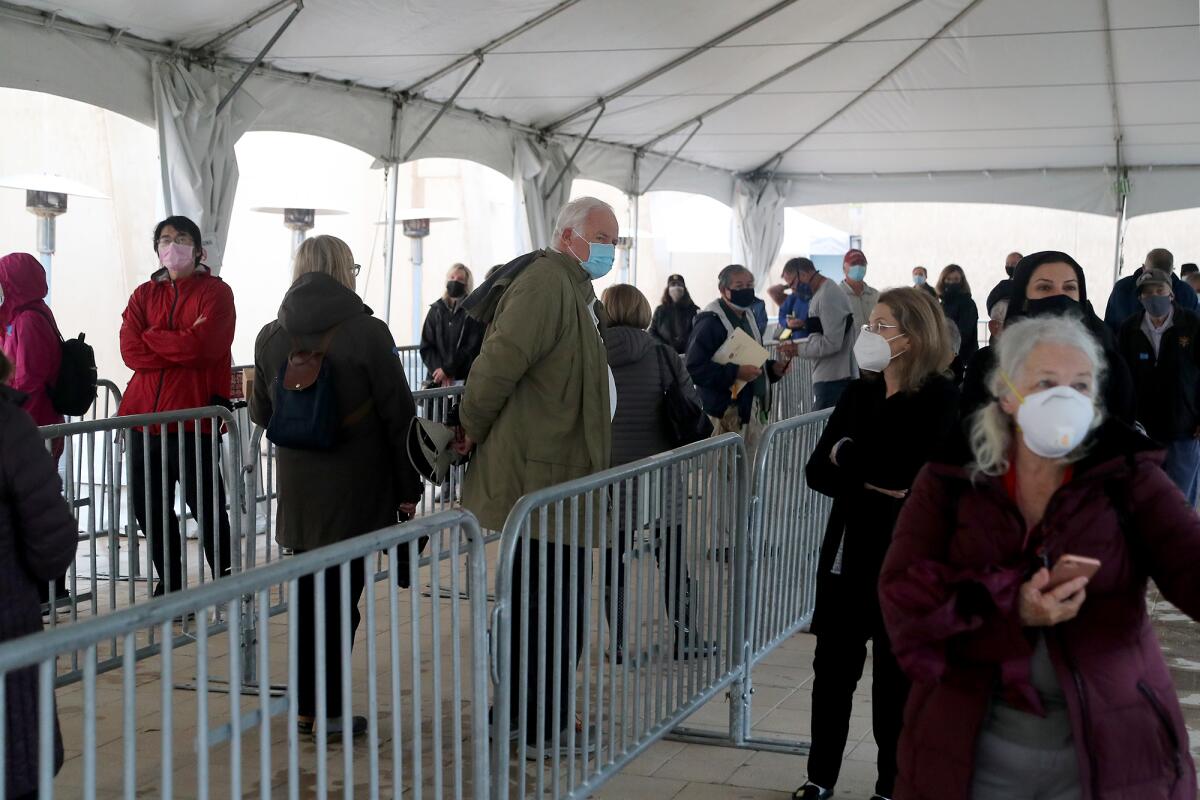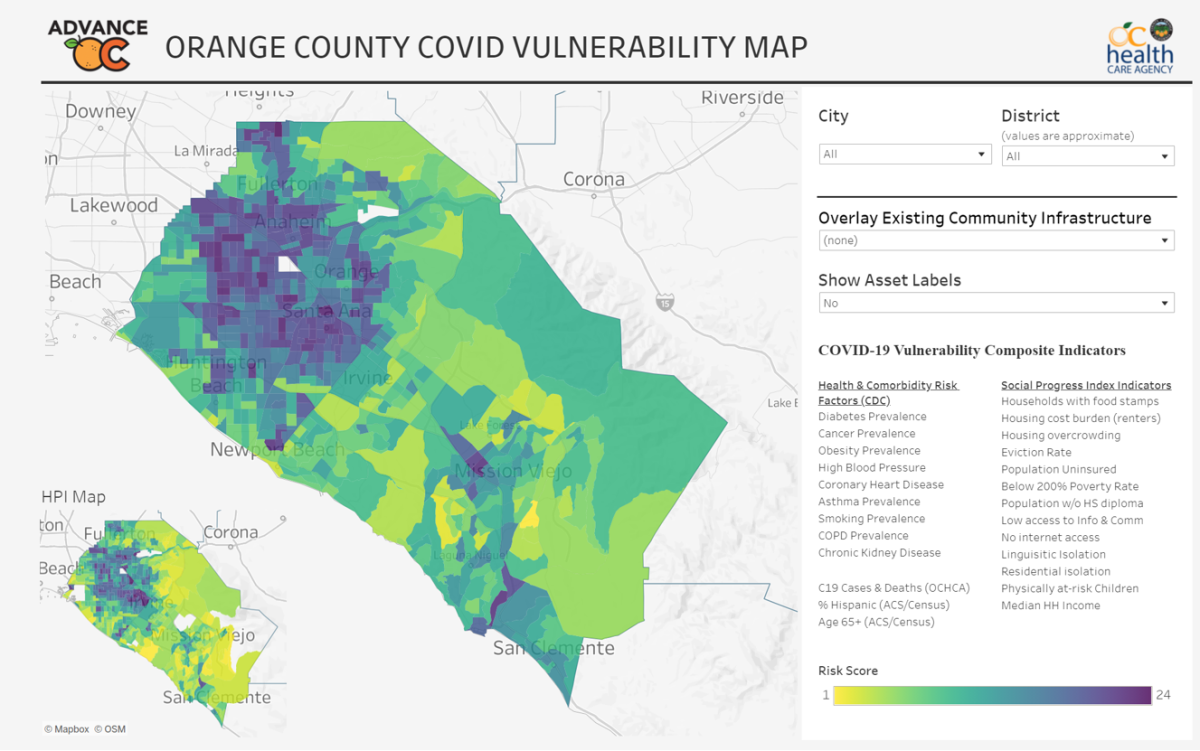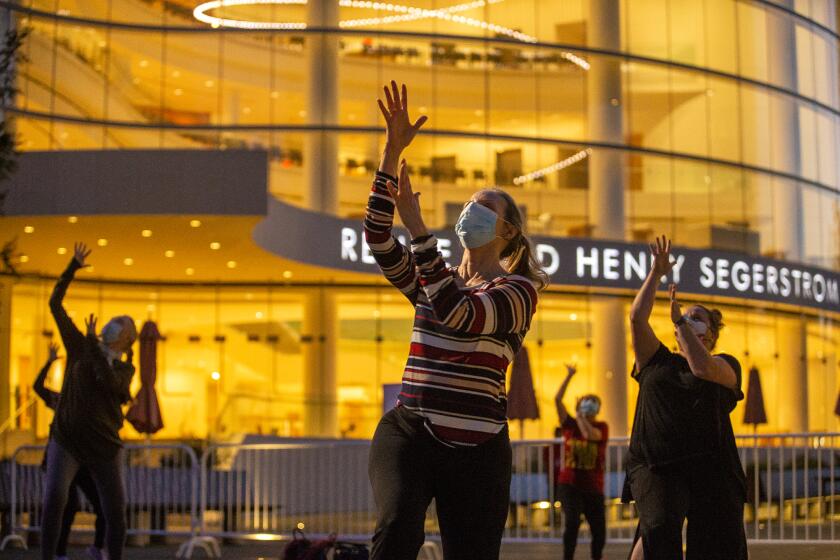Studies identify social and racial disparities in Orange County during first COVID-19 surges

- Share via
Orange County residents from ZIP codes with higher-density households, lower education and less insurance coverage were more likely to be infected by and die from the coronavirus that causes COVID-19.
Asian residents were also more likely to die from the virus than whites, and men, the elderly and Latino people were more likely to be diagnosed with COVID-19.
A recently published UC Irvine study reveals these racial and social disparities in infection and mortality rates during the first surge of the pandemic last summer.
Researchers used data on COVID-19 testing and mortality rates from the Orange County Health Care Agency from March 1 to August 16, 2020. The researchers also conducted a survey from July 10 to Aug. 16 last year, largely encompassing the first surge of the virus. UC Irvine received help in collecting antibody data — which indicates a history of exposure to the virus — from the health care agency from people at 11 drive-through sites in the county.
Researchers found that even after controlling for socioeconomic factors — like living in low-income neighborhoods — Latino people had 1.7 times more chance of testing positive for the virus than white people.
Daniel Parker, UCI assistant professor of public health and an author of the study, also pointed out that risk factors for infection shifted. Cases were initially clustered in affluent coastal areas, but eventually became more concentrated in north and central Orange County. Santa Ana and Anaheim, with their high Latino populations, have taken the brunt of the pandemic in the county.
Santa Ana accounts for 47,321 of the county’s 281,609 cases. Anaheim has the next highest case count with 45,063 cases.
Theaters and concert halls across O.C. commit to new audience, artist safety protocols
“What it does tell us is that it can shift really fast,” Parker said. “I know from some of the analyses I’ve been doing that we’re seeing infections in much younger people — it’s more common to see younger people in the hospitals and also in reported cases. So, the lesson is that these socioeconomic factors are really important drivers of the epidemic.”
Parker said hateful incidents and rhetoric directed at the Asian community may have led to fewer Asian people seeking a medical diagnosis. During the first wave of the virus and until he was voted out of office, former President Donald Trump railed on the “China virus.” During the pandemic, reports of hate incidents increased against the Asian community.
“So maybe if you’re Asian and you’re feeling sick, you’re going to wait a little bit longer to get diagnosed because there’s a lot of stigma around this,” Parker speculated. “What this means is you have less on average being diagnosed, but the deaths are still happening. So it wouldn’t necessarily be that there’s a biological reason that Asians are higher risk of death. It’s just among those who tested positive, were more likely to die at this time anyways, during the first wave.”
Following Parker’s study, UC Irvine partnered with the city of Santa Ana for a more in-depth look at the city’s COVID-19 infection rate during the infant weeks of the massive winter surge. That study was led by Bernadette Boden-Albala, the director of UC Irvine’s Program in Public Health.

The Santa Ana study was unique because it focused on households, including children. In the past, research into COVID-19 centered on adults, as many believed children were less likely to catch the virus. This belief was refuted during this summer’s third surge, with young people accounting for a majority of the cases in Orange County with the spread of the Delta variant.
“We really wanted to look at why was there this high burden community — what was this really about,” Boden-Albala said of Santa Ana. “So I think we really got into the heart of a community with a lot of COVID to find what really happened.”
Researchers found that the community was hit particularly hard because many residents were considered essential workers and had to continue to go into work rather than working virtually from home, increasing their chances of exposure to the virus. Many households in Santa Ana are also higher density with multiple people living in them, which can increase the chances of spreading the virus. Being Latino also increased one’s chances of getting sick.
“A lot of this suggests that the policy to stay home, while good and protected a lot of people overall, didn’t really protect essential workers,” Boden-Albala said. “So essential workers ended up with the greatest burden of disease.”
Parker and Boden-Albala said it’s important for the county and cities to utilize community-based organizations to bring treatment to the neighborhoods that have been hardest hit by the pandemic. They also mentioned that it’s important for local governments to work with community clinics.
There have been concerns throughout the pandemic that the county hasn’t adequately included underserved communities in its vaccine distribution plans, which once focused on mass sites called Super PODs at Disneyland and other high-traffic areas.
According to state data, which was last updated on Aug. 16, Latinos account for 13.4% of the vaccinated residents of Orange County, despite accounting for 35% of the county’s population. Asian Americans and Pacific Islanders account for 14% of the county’s vaccinated and make up 21.9% of the county’s population. White people account for 24.8% of the vaccinated and make up 38.6% of the population.
“I feel like working through groups like that is one effective way of reaching communities that might be a little bit resistant to work with academics or with government officials,” Parker said of the community health groups.
To help with reaching the underserved neighborhoods, the county rolled out a mobile vaccine system in June. It allows people to order a mobile unit to their neighborhood, though at least 50 patients are preferred to be present.

The county also recently announced the creation of an equity map to help fix the social and health inequities officials say were revealed and worsened by the COVID-19 pandemic.
The O.C. Health Care Agency used the map to determine where it should perform vaccine outreach. Karin Kalk, director of project management and quality improvement at the agency, said in a previous interview that the county deployed mobile vaccination units to the neighborhoods and census tracts that were most in need of the vaccine.
Kalk said the county will use the map to help guide its allocation of a $22.8-million grant from the Centers for Disease Control and Prevention, which is meant to be used for COVID-19-related health disparities. The county will also be forming a coalition guided by the map to help solve high-priority COVID-19-related needs in the community.
The county also has equity initiatives aimed at the Latino and Asian American and Asian Pacific Islander communities.
The Latino Health Equity Initiative, launched in June 2020, is a partnership between the county, Latino Health Access, Santa Ana and Anaheim Unified School districts and the coalition.
The Asian American/Pacific Islander initiative is a partnership between the county and the Orange County Asian Pacific Islander Community Alliance and Korean Community Services “to address barriers to testing and care that these communities may experience.”
The initiative includes the Asian Pacific Islander Task Force, which offers testing, outreach and other services.
According to recent state data, Latino people account for 34.9% and the Asian community for 12.1% of the county’s COVID-19 cases. White people account for 48% of the cases in Orange County.
UC Irvine statistics professor Vladimir Minin said in an email that the likely shift in the racial groups could have occurred by a combination of two factors.
“Northern O.C. was hit very hard during the previous two waves (Summer 2020 and Fall 2020/Winter 2021),” Minin wrote, “so the Latino community has accumulated substantial natural immunity (probably at a very high cost, unfortunately) and the Orange County Health Care Agency in partnership with UC Irvine and local community organizations (e.g., Latino Health Access) did work hard to vaccinate the Latino community to insure equitable vaccine distribution ...
“To sum up, it is likely that the Latino community has higher immunity (natural plus vaccine induced) than the white residents of O.C. This is still probably a bit overly simplistic, because behavioral factors (social distancing, mask wearing, etc.) play a role too.”
All the latest on Orange County from Orange County.
Get our free TimesOC newsletter.
You may occasionally receive promotional content from the Daily Pilot.





